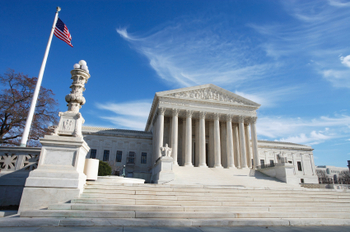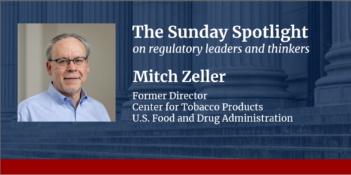
Recent cases and proposed legislation reveal decreasing deference to agencies’ interpretation of their own regulations.
Last month, the House and Senate held hearings on the future of judicial deference to administrative interpretations of law. House and Senate Republicans then introduced the Separation of Powers Restoration Act, which would amend the Administrative Procedure Act to instruct courts to abandon their current practice of giving special deference to agency interpretations of the statutes and regulations they implement. When introducing the bill, U.S. Senator Orrin Hatch (R-Utah) remarked that “the courts stand as the only truly independent check on out-of-control regulators, but judicial deference to the agencies undercuts the courts’ ability to hold the government accountable to the law.”
This sweeping legislative proposal did not appear out of thin air. Chevron deference—the doctrine that courts must defer to an agency’s reasonable interpretation of an ambiguous statute the agency administers—celebrated its 30th birthday in 2014. But ever since its birth, Chevron has been the subject of much criticism (and praise). In recent years, however, the criticism seems to have intensified. New Chevron skeptics have emerged on the Supreme Court, in the legal academy, and in the real world. A sample of the criticism from the Supreme Court over the last five years is illustrative.
In 2013, the Court decided City of Arlington v. FCC, which held that Chevron deference applies to statutory ambiguity concerning the scope of an agency’s regulatory authority. Chief Justice John Roberts, joined by Justices Anthony Kennedy and Samuel Alito, dissented. The dissent bemoaned the sprawl of the modern administrative state and how it “wields vast power and touches almost every aspect of daily life.” To combat this administrative power, the dissenters argued that Chevron deference should not apply to any statutory ambiguity whenever Congress has granted the agency general rulemaking or adjudicatory power. Instead, courts should evaluate whether Congress intended to delegate interpretive authority as to the “specific provision of the statute”—“the statutory ambiguity at issue.”
Criticism of judicial deference to agency interpretation deepened last year. Different Justices’ opinions in Perez v. Mortgage Bankers Association took aim at Chevron’s sister doctrine, Auer deference, which instructs courts to defer to an agency’s interpretation of its own regulation unless the interpretation is plainly erroneous. Previously, both in 2011 and then again in 2013, Justice Scalia expressed concerns with Auer deference. It seems unconstitutional, Justice Scalia argued, for a law’s drafter also to be its interpreter; moreover, such deference creates perverse incentives for agencies to leave ambiguities in regulations, he posited.
In last year’s Mortgage Bankers case, Justices Thomas and Alito joined Justice Scalia’s call to revisit Auer. Drawing on Professor Philip Hamburger’s new book, Justice Thomas expressed the constitutional concern that Auer “undermines our obligation to provide a judicial check on the other branches, and it subjects regulated parties to precisely the abuses that the Framers sought to prevent.” As I have noted elsewhere, a suitable case to reconsider Auer might be Bible v. United States Aid Funds, Inc., a case from the U.S. Court of Appeals for the Seventh Circuit, which the Supreme Court will soon decide whether to review. With Justice Scalia’s passing, however, it seems less likely that four Justices—the minimum required for the Court to decide to hear a case on the merits—would be interested in reconsidering Auer at this time.
Last year, Justice Clarence Thomas not only articulated the constitutional case against Auer, but he also made the constitutional case against Chevron. In his concurring opinion in Michigan v. EPA, Justice Thomas argued that Chevron deference “is in tension with Article III’s Vesting Clause, which vests the judicial power exclusively in Article III courts, not administrative agencies.” Moreover, he argued, Chevron deference is tension with Article I of the U.S. Constitution, “which vests ‘all legislative Powers herein granted’ in Congress.”
Finally, in King v. Burwell, Chief Justice Roberts, writing for the Court last year, may have brought us full circle to his dissent in City of Arlington. Although the Court ultimately sided with the federal government in interpreting the Affordable Care Act’s tax credit provisions, the Court refused to accord any deference to the U.S. Department of the Treasury regulation interpreting the statute. Instead, the Chief wrote that Chevron deference does not apply to questions like this that are “of deep ‘economic and political significance.’” That is because there is no evidence that Congress intended to delegate such an important question to an agency, much less to the Internal Revenue Service, which had adopted the regulation but which the Court found to have “no expertise in crafting health insurance policy of this sort.”
As I noted when it was announced, King seems like a judicial power grab over the Executive in the modern administrative state. It also seems like a return to the Chief’s dissent in City of Arlington, at least with respect to major questions. In those circumstances, King suggests that a provision-specific inquiry into congressional intent to delegate is warranted. I have since wondered whether this new major-questions doctrine will limit Chevron’s domain, or whether it is a one-off decision good for tax only. We should soon discover the answer, as litigants have raised the doctrine in a number of cases, including in challenges to the Federal Communications Commission’s net neutrality regulation, the Obama Administration’s executive actions on immigration, and the U.S. Environmental Protection Agency’s Clean Power Plan—just to name a few.
The arguments advanced in these various Supreme Court opinions figure prominently in the co-sponsor statements that accompanied the Separation of Powers Restoration Act. To be sure, the likelihood of this legislation becoming law is quite low, especially under this presidential Administration. In light of Justice Scalia’s passing, moreover, the Supreme Court is similarly less likely to rethink judicial deference to agency interpretations. If the last five years are any indication of the next five, however, we should see a further judicial chipping away of Chevron deference—and even more judicial and scholarly calls for drastic reform.
The stakes are high. For one, deference doctrines limit the judiciary’s power to rein in the regulatory state. There is also empirical evidence to suggest that agencies think about Chevron deference when regulating, and that they may be more aggressive in their interpretive practices if they believe that courts will defer to their interpretations.
This essay is part of The Regulatory Review’s sixteen-part series, RegBlog@5.




